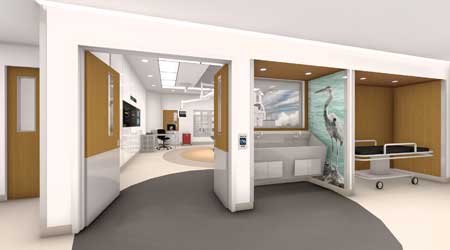 Combining the latest in technology with pleasing installations depicting the outdoors creates a calm and inviting space for high stress job functions.Taylor Design
Combining the latest in technology with pleasing installations depicting the outdoors creates a calm and inviting space for high stress job functions.Taylor DesignExplaining Experiential Design's Benefit for Healthcare Facilities
Not a new concept, and long proven successful in retail, experiential design is making its way into healthcare facilities, partly because it dovetails nicely with sustainability.
For healthcare interiors today, the marriage of experiential design with sustainable materials and practices creates an environment that aids in positive patient outcomes while furthering the business and social responsibility interests of the healthcare organization.
Experiential design is not a new concept. For many years, retail stores and other purveyors of goods have been attracting customers with the opportunity to do more than just shop. Examples of this effort to shape the customer experience include bookstores that sell coffee and snacks, and malls that sponsor free on-site massages.
Tom’s Shoes offers a different spin on experiential retail by allowing the buyer the opportunity to take an active role in the company’s charitable efforts. In the “Stand for Tomorrow” promotion, Tom’s customers can direct a portion of their purchase price to one of six social causes that the company supports. In this way, consumers know that at least some of the money they spend on a product will have a social impact.
Other industries have seized on the trend of creating a customer experience to enhance their core offering, including hospitality (e.g., water parks, in-room virtual reality sets) and corporate offices (e.g., elaborate video displays, personal services).
Among healthcare organizations, this trend is resulting in efforts to improve the experience of hospital stays and visits. Patients can partake in workshops, cooking classes, yoga, and educational programs focused on health and wellness. Once checked-in, patients are free to take advantage of the many services and activities now offered in the lobby and waiting areas until their electronic device informs them it is time for their appointment.
Healthcare facilities have only scratched the surface when it comes to experiential design. By appealing to the five senses, and creating memorable immersive experiences, healthcare groups can create a place of joy, amazement, and wonderment. This is especially important in a healthcare setting, where visitors and patients are often in an unfamiliar place, or worse, facing a potentially life-altering event.
The need for smart, well-planned experiential design is even more pressing now, as the healthcare market is facing pressure from increased costs, changing policies and regulations, as well as increased competition for both staff and patients.
The challenge that lays before the industry is to brand the hospital experience to be unique and personalized to the community it serves. And as millennials and Generation Z become the dominant market for healthcare facilities — whether as custodians of their aging parents or as patients themselves — this challenge will be intensified because these groups increasingly factor the social and ethical impact of their choice into decision making.
Consider the popularity of the boutique clinic. People want a clean and inviting space that doesn’t feel scary, and that doesn’t look, smell and feel like a hospital. Even more, they want food service options or cafes that are in alignment with their commitment to sustainability. They want to be informed about the choices that their hospital makes towards selecting organic and local produce. Are the bags they are using biodegradable? Does the coffee they are drinking come from a socially responsible and sustainable source?
Commercial office settings have successfully engaged their customers and staff with highly branded lobbies and immersive technology that personally engages the viewer. This builds on brand loyalty and creates a memorable, “Instagrammable” image.
Ultimately, experiential design merges “high-touch” hospitality service with the sales process. It marries the design of physical space with the emotional art of making someone feel comfortable in their surroundings. Interior design in healthcare can do a better job of this. And with new generations beginning to overtake Baby Boomers and their parents in numbers and social significance, securing brand loyalty will rely greatly on how well a facility reassures its customer base that the institution stands for something greater.
Related Topics:












